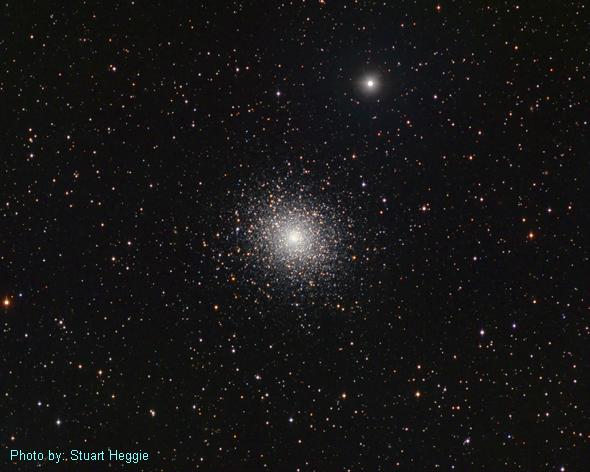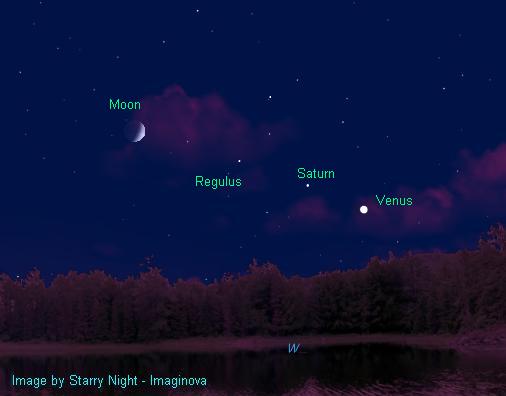The Herdsman and the Snake
Sometimes known as the Hunter or the Ploughman, the constellations Bootes is most commonly referred to as the Herdsman. Taking on the appearance of a giant celestial kite soaring amongst the stars, this constellation holds one very bright star. To locate it, following the stars in the Big Dipper’s handle which arcs down to the star Arcturus. This K0 supergiant shines 113 times brighter than our Sun and emits 215 times more radiation. It measures 26 solar diameters across or one quarter the size of the orbit of Mercury. Located 37 light-years from us the light of this magnitude -0.1 star was used to open the 1933 World’s Fair in Chicago.
Looking ten degrees north of Arcturus along the left side of the kite is Epsilon Bootes. Shining at second magnitude and lying some 209 light-years (ly) away, this nice but difficult double star displays a pallet of pale yellow and light blue dots. They are separated by a mere 2.9 arc seconds thus requiring medium size optics to split. Independently these suns glow at magnitudes 2.7 and 5.1 respectively.

The only globular cluster resides within the boundaries of Bootes of NGC 5466. It is however fairly dim for a globular. Situated a lengthy 47,000 ly from us, this magnitude 10.0 smudge will require at least a four-inch telescope to begin resolving it. And even when you do, it will appear scarcely populated. A trick to locating NGC 5466 is to first find the 7th magnitude globular cluster M3 in Canes Venatici, a very bright and dense globular. Now move your scope a little more than five degrees to the east and you will pick it up with a bit of luck.
So who is up for a challenge? For those who are, we have Arp 297. This faint group of four galaxies consists of NGC 5752 at 14th magnitude, NGC 5753 at 15th, NGC 5755 at 15th and the largest and brightest member NGC 5754 at magnitude 13.8. Arp galaxies are basically, faint peculiar objects. Some of these shapes and interactions are quite remarkable. The marker galaxy NGC 5754 is located a little east of the midpoint of the imaginary line between Nekkar and Seginus at the top of the kite.
As we slide over to Serpens, we find ourselves again in galaxy country. Starting from the head and NGC 5962, this 12th magnitude island of stars possesses many tight galactic arms and has a bright core. One of the brightest galaxies within the boundaries of the constellation is NGC 5921. A nice face-on orientation, this galaxy sported a supernova in early 2001.

Without question before going any further, you just hunt down M5. Listed just under naked eye visibility, this magnitude 5.8 gem is a nice distraction from looking at or trying to find faint fuzzies mentioned in this article. Stuart Heggie, who lives near Flesherton, Ontario, took this remarkable portrait of M5. You can easily resolve stars right down to the core – nice work Stuart. Another of the numerous targets to the lower left of the constellation is NGC 6070. This is another elongated galaxy residing an estimated 83 million ly. At magnitude 12.5, it will be a bit hard to discern its structure but it has a somewhat bright nucleus.

This month is pretty well the last time we can adore the mighty ringed planet Saturn. What do you get when you mix two planets, a bright star, and the crescent Moon, you get a great lineup. This will take place in the western skies on June 20th. Get those cameras ready for a great visual grouping. And as we bid farewell to Saturn, the king of planets – Jupiter is low in the southern skies after twilight. Over the past few months, Jupiter has undergone some serious changes to its belt and zone structure. The change to the equatorial zone is unmistakable.
The Space Shuttle Atlantis is set to launch on Friday, June the 8th at 7:38 EDT. Through the marvels of technology, you can follow the entire mission from pre-launch to the return landing on your computer. Just click on the link to NASA TV and select with Media player or Realplayer. Once they link up in space, the two will be extremely bright as they pass over your area. You can plan future passes by logging on to the Heavens-Above web site.

Our daytime star – the Sun is sporting new life as reports are coming in that activity in the form of Coronal Mass Ejecta is on the upswing. With luck, you should witness aurora activity sometime this month. Keep an eye on the alerts and your cameras ready.
Of course, summertime is made for star parties and there are numerous outings planned across the country. This is ideal for introducing the general public to the night sky and exactly what we do. Take the time to participate in these sessions whether it’s a large star party of a sidewalk session outside your local library or bookstore. There is no greater reward than to see the ear to ear smile of someone’s first view of Saturn or the Moon through a telescope.
And finally, the summer solstice occurs on June 21st at 18:06 UT. This marks the beginning of summer in the northern hemisphere and winter in the south. From here on till the frosty nights of December, the nights gradually shorten.
Until next month,
Clear skies
Gary Boyle
| Object | Type | Magnitude | RA | DEC |
|---|---|---|---|---|
| Arp 297 | Brightest of group - round | 15.0 | 14h 45m | 38° 45m |
| IC 4543 | Planetary nebula | 15.0 | 15h 25m | 13° 27m |
| M 13 | Globular cluster | 7.0 | 11h 19m | 13° 02m |
| M 3 | Globular cluster | 7.0 | 13h 13m | 18° 07m |
| M 5 | Globular cluster | 5.8 | 15h 19m | 02° 03m |
| M 92 | Globular cluster | 7.5 | 13h 16m | 42° 02m |
| NGC 5770 | Round galaxy | 13.2 | 14h 53m | 03° 54m |
| NGC 5775 | Very elongated galaxy | 12.3 | 14h 54m | 03° 38m |
| NGC 5792 | Elongated galaxy | 12.1 | 14h 58m | -01° 06m |
| NGC 5806 | Elongated galaxy | 12.5 | 15h 00m | 01° 52m |
| NGC 5813 | Round galaxy | 11.5 | 15h 01m | 01° 40m |
| NGC 5831 | Round galaxy | 12.5 | 15h 04m | 01° 11m |
| NGC 5846 | Round galaxy | 13.8 | 15h 07m | 01° 34m |
| NGC 5850 | Elongated galaxy | 11.6 | 15h 07m | 01° 31m |
| NGC 5921 | Round galaxy | 11.5 | 15h 22m | 05° 02m |
| NGC 5936 | Round galaxy | 13.1 | 15h 30m | 12° 57m |
| NGC 5951 | Very elongated galaxy | 13.8 | 15h 34m | 14° 58m |
| NGC 5953 | Round galaxy | 12.9 | 15h 34m | 15° 10m |
| NGC 5956 | Round galaxy | 13.2 | 15h 35m | 11° 43m |
| NGC 5957 | Round galaxy | 12.9 | 15h 36m | 12° 01m |
| NGC 5962 | Elongated galaxy | 12.0 | 15h 36m | 16° 35m |
| NGC 5964 | Round galaxy | 12.9 | 15h 40m | 05° 57m |
| NGC 5970 | Elongated galaxy | 12.1 | 15h 38m | 12° 09m |
| NGC 5980 | Elongated galaxy | 13.3 | 15h 41m | 15° 45m |
| NGC 5984 | Very elongated galaxy | 13.3 | 15h 43m | 14° 12m |
| NGC 5996 | Elongated galaxy | 13.2 | 15h 47m | 17d° 50m |
| NGC 6004 | Round Galaxy | 13.0 | 15h 50m | 18° 54m |
| NGC 6012 | Elongated galaxy | 12.7 | 15h 54m | 14° 33m |
| NGC 6210 | Planetary nebula | 9.0 | 16h 45m | 23° 48m |
